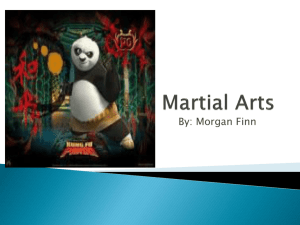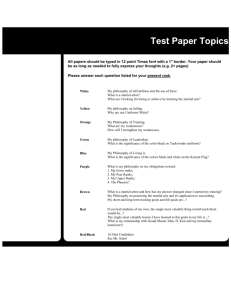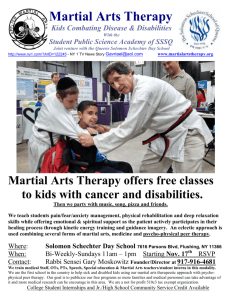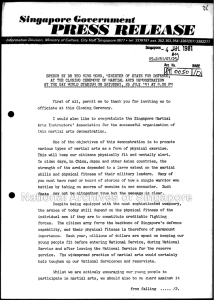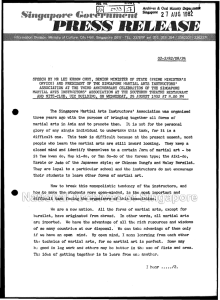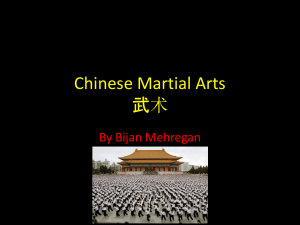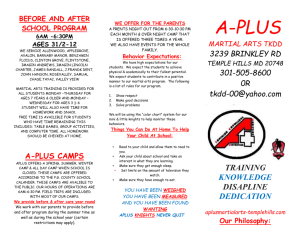PE 64 course syllabus Spring 2015
advertisement
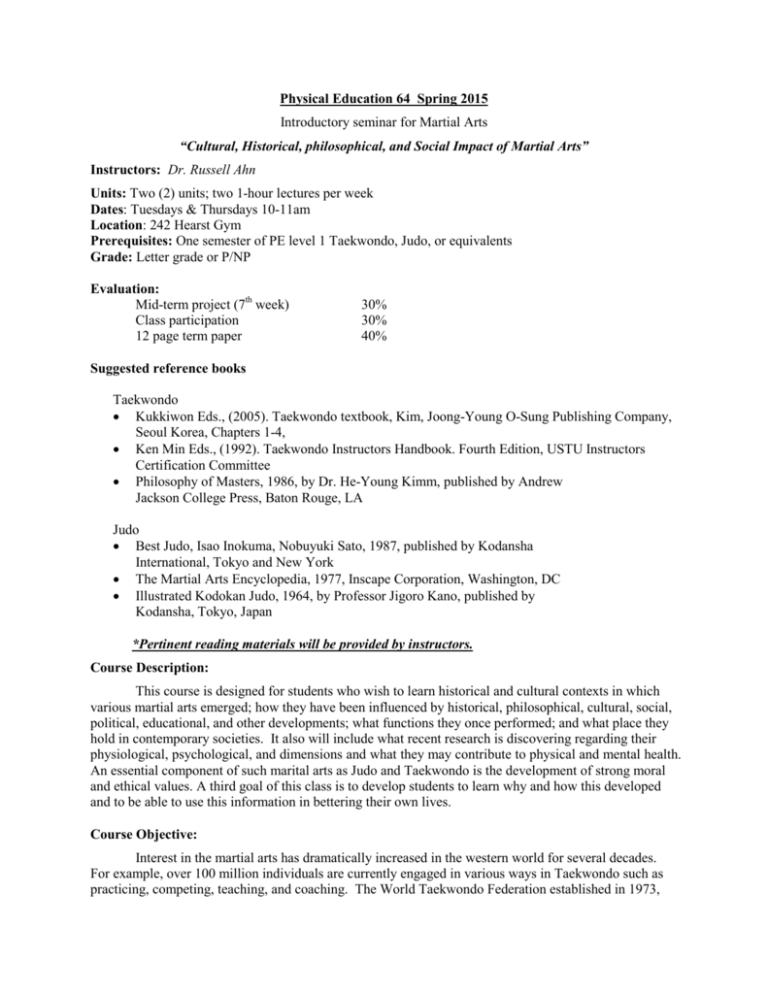
Physical Education 64 Spring 2015 Introductory seminar for Martial Arts “Cultural, Historical, philosophical, and Social Impact of Martial Arts” Instructors: Dr. Russell Ahn Units: Two (2) units; two 1-hour lectures per week Dates: Tuesdays & Thursdays 10-11am Location: 242 Hearst Gym Prerequisites: One semester of PE level 1 Taekwondo, Judo, or equivalents Grade: Letter grade or P/NP Evaluation: Mid-term project (7th week) Class participation 12 page term paper 30% 30% 40% Suggested reference books Taekwondo • Kukkiwon Eds., (2005). Taekwondo textbook, Kim, Joong-Young O-Sung Publishing Company, Seoul Korea, Chapters 1-4, • Ken Min Eds., (1992). Taekwondo Instructors Handbook. Fourth Edition, USTU Instructors Certification Committee • Philosophy of Masters, 1986, by Dr. He-Young Kimm, published by Andrew Jackson College Press, Baton Rouge, LA Judo • Best Judo, Isao Inokuma, Nobuyuki Sato, 1987, published by Kodansha International, Tokyo and New York • The Martial Arts Encyclopedia, 1977, Inscape Corporation, Washington, DC • Illustrated Kodokan Judo, 1964, by Professor Jigoro Kano, published by Kodansha, Tokyo, Japan *Pertinent reading materials will be provided by instructors. Course Description: This course is designed for students who wish to learn historical and cultural contexts in which various martial arts emerged; how they have been influenced by historical, philosophical, cultural, social, political, educational, and other developments; what functions they once performed; and what place they hold in contemporary societies. It also will include what recent research is discovering regarding their physiological, psychological, and dimensions and what they may contribute to physical and mental health. An essential component of such marital arts as Judo and Taekwondo is the development of strong moral and ethical values. A third goal of this class is to develop students to learn why and how this developed and to be able to use this information in bettering their own lives. Course Objective: Interest in the martial arts has dramatically increased in the western world for several decades. For example, over 100 million individuals are currently engaged in various ways in Taekwondo such as practicing, competing, teaching, and coaching. The World Taekwondo Federation established in 1973, now includes 188 member nations. Interestingly, the growing popularity of Taekwondo started shortly after the US recognized Taekwondo as one of the amateur sports under the AAU (Amateur Athletic Union) in 1974, and other countries also began adopting Taekwondo as an amateur sport. Global expansion of Martial arts is rapidly progressing not only with practitioners but also through other cultural phenomena such as TV, movies, demonstrations, tournaments and exhibitions. This class will give an overall understanding of martial arts’ history, philosophy, and cultural implications. Related to be the lecture part of the course there will be reading assignments, observing selected martial arts classes and audio-visual materials to have better understanding. Students may choose a class from Taekwondo, Yongmudo, Judo or Kumdo class for observing classes. As appropriate for selected topics, there may be an occasional guest lecturer, such as an individual who has an advanced degree in psychology or both psychology and appropriate training in martial arts. Overview of Course Content I. History and philosophy Week # 1: Introduction to Martial arts and overview of the course Week # 2: Historical origins of selected marital arts Week # 3: Philosophy of martial arts Week # 4: Various martial arts II. Area focused studies Week # 5: Taekwondo Week # 6: Taekwondo *outline of term paper due Week # 7: Judo *Midterm Group Projects Week # 8: Judo III. Contemporary martial arts research Week # 9: Educational value of martial arts Week # 10: Psychological, Social and Cultural Aspects IV. Martial arts in the Western world Week # 11: Introduction of Asian Martial Arts in US Week # 12: The growth of Asian martial arts in the United States and Western world from 1952s to current (background history of martial arts developments through AAU, USTU, NCTA, and USJA) Week # 13: Leadership & Globalization of Martial Arts: WTF, IJF, FISU, IOC etc. IV. Presentations and review Week # 14: Presentation and discussions of papers Week # 15: Final paper due will May 8th 2015
